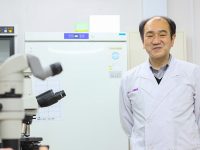Researchers propose a comprehensive non-targeted approach for identifying foreign chemicals in maternal serum samples and their potential effect on metabolic pathways
In the past, chemicals like asbestos and lead have caused widespread harm before their dangers were fully understood. Today, many unknown chemicals similarly pose potential risks. Recently, Chiba University researchers developed a new analysis method for detecting such chemicals in the human body. By studying blood samples from pregnant women, they identified 106 compounds, including potentially harmful substances like phthalates and parabens. This innovative approach could inform new regulations to better protect public health.

Image title: A non-targeted method for identifying exogenous and endogenous compounds in the human body.
Image caption: In a new study, researchers at Chiba University have combined advanced statistical techniques with chemical analysis to detect a wide range of chemicals present in human serum and assess their potential effects on health.
Image credit: Akifumi Eguchi from Chiba University (Images of tube and computer are from TogoTV (© 2016 DBCLS TogoTV, CC-BY 4.0)
Image source link: https://www.sciencedirect.com/science/article/pii/S0147651324013320
Image license: CC-BY 4.0
Usage restrictions: Credit must be given to the creator.
From the 1960s to the 1980s, the use of lead in fuel, paints, and pipes caused widespread contamination. It is estimated that 170 million Americans alive today were exposed to high lead levels as children, which caused significant harm, including a measurable drop in IQ scores. While we now understand the dangers of these chemicals, large sections of the population are still exposed to them. UNICEF reports that about 800 million children globally, nearly half of whom live in South Asia, are still exposed to unsafe levels of lead resulting from the hazardous recycling of lead-acid batteries.
Much like the hidden dangers of lead in the past, many of the chemicals we are exposed to today remain poorly understood, along with their potential long-term health effects. To address this issue, researchers at Chiba University in Japan have recently developed an innovative method to detect unrecognized foreign chemicals in the human body. The study was made available online on 26 October 2024 and was published in Volume 286 of the journal Ecotoxicology and Environmental Safety on 1 November 2024. Led by adjunct researcher Dr. Akifumi Eguchi, the study included contributions from Dr. Chisato Mori, Dr. Kenichi Sakurai, and Dr. Midori Yamamoto from the Center for Preventive Medical Sciences at Chiba University.
“There is a growing need for non-targeted chemical analysis to detect new or previously unrecognized substances that are not covered by current targeted analyses,” says Dr. Eguchi, emphasizing the need for broader analytical approaches.
Non-targeted chemical analysis poses significant challenges owing to the large volume of data involved. Additionally, since chemicals exist in various forms, it is necessary to distinguish between endogenous (those naturally produced by the body) and exogenous (those derived from external sources like air, water, or food) chemicals. To address this, the proposed method uses advanced statistical techniques, including Principal Component Analysis, regularized Generalized Canonical Correlation Analysis, Uniform Manifold Approximation and Projection, and OPTICS clustering. These approaches reduce data complexity and help reveal patterns and groupings among the chemical compounds present in the samples, providing deeper insights into their origins and potential impacts.
Using this method, the researchers analyzed serum samples from 84 pregnant women at 32 weeks of pregnancy. These samples were then examined using Liquid Chromatography-Quadrupole Time-of-Flight Mass Spectrometry. The detected chemicals were classified based on their origin using the PubChemLite for Exposomics database, which contains information on over 371,663 chemicals. Endogenous chemicals were identified as those naturally produced by the body and associated with biological pathways, while exogenous chemicals were categorized as substances introduced from external sources such as the environment, diet, or lifestyle.
The researchers identified 106 compounds, of which 51 were endogenous and 55 were exogenous. Most of the exogenous chemicals were found to have been introduced into the body through dietary sources. Additionally, they found compounds associated with possible health risks, such as phthalates, nitrogenous compounds, and parabens. Moreover, some of the chemicals identified were found to impact biological pathways, such as amino acid metabolism, protein and mineral transport, and energy metabolism.
While these findings show a link between chemical exposure and its effects on the body, the researchers emphasize that they do not establish a direct cause-and-effect relationship. Since most of the exogenous chemicals were linked to dietary sources, it remains unclear whether the changes in metabolites are due to the substances themselves or the diet. Despite these limitations, the study offers a new method for identifying chemicals and evaluating their potential effects on human health.
“These findings can contribute to public health improvement through the implementation of chemical regulations and related protective measures,” says Dr. Eguchi. Just as the realization of dangers associated with lead and asbestos led to significant reform and restrictions on these chemicals, the results of this study could help identify new potentially harmful chemicals, paving the way for better regulations to protect human health.
About Akifumi Eguchi Dr. Akifumi Eguchi is an environmental and public health researcher with expertise in environmental chemistry, analytical chemistry, and epidemiology. He serves as a lecturer at the Center for Preventive Medical Sciences, Chiba University, and a project researcher at the University of Tokyo and Keio University. Dr. Eguchi earned his PhD in Science from Ehime University, where he also completed his undergraduate and master’s studies in agriculture. His research focuses on understanding the impact of environmental exposures on public health, particularly through innovative chemical analysis techniques.
Funding: This study was supported by grants from the Japan Society for the Promotion of Science (23H00539), JST OPERA Program Japan (JPMJOP1831), and an unrestricted grant from the Yamada Bee Company, Japan. This research was also performed by the Environment Research and Technology Development Fund (JPMEERF20245M01) of the Environmental Restoration and Conservation Agency provided by the Ministry of the Environment of Japan.
Reference:
Title of original paper: Elucidation of endogenous and exogenous chemicals in maternal serum using high-resolution mass spectrometry
Authors: Akifumi Eguchi1*, Kenichi Sakurai1, Midori Yamamoto1, Chisato Mori1,2
Affiliations:
1Center for Preventive Medical Sciences, Chiba University, Japan
2Department of Bioenvironmental Medicine, Graduate School of Medicine, Chiba University, Japan
Journal: Ecotoxicology and Environmental Safety
DOI: 10.1016/j.ecoenv.2024.117256
Contact: Akifumi Eguchi
Center for Preventive Medical Sciences, Chiba University
Email: a_eguchi@chiba-u.jp
Public Relations Office, Chiba University
Address: 1-33 Yayoi, Inage, Chiba 263-8522 JAPAN
Email: koho-press@chiba-u.jp
Tel: +81-43-290-2018
Recommend
-

The World of Mold around Us: The A to Z of Mold
2023.04.06
-

Bringing Japan’s renowned experiment-based science education to Southeast Asia: Developing sustainable physics teaching materials for the pursuit of a disparity-free society
2023.11.24
-

Charting a New World Atlas of Mathematics and Geometry: Transforming Differential Equations into Figures
2025.03.19


